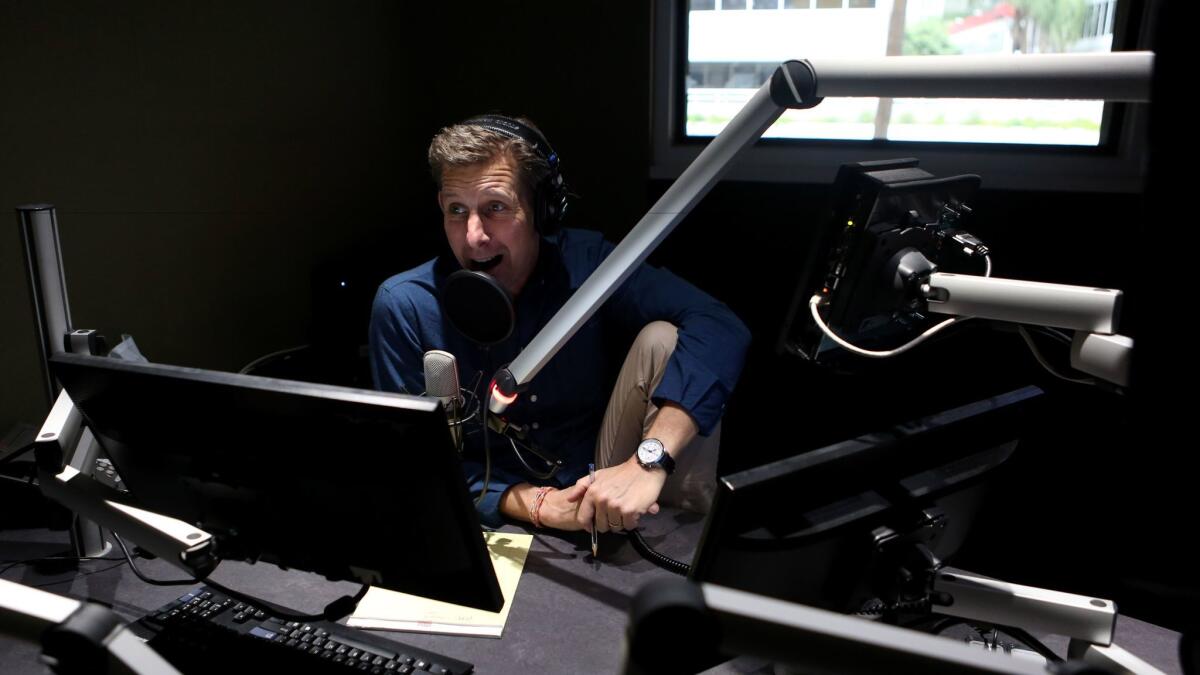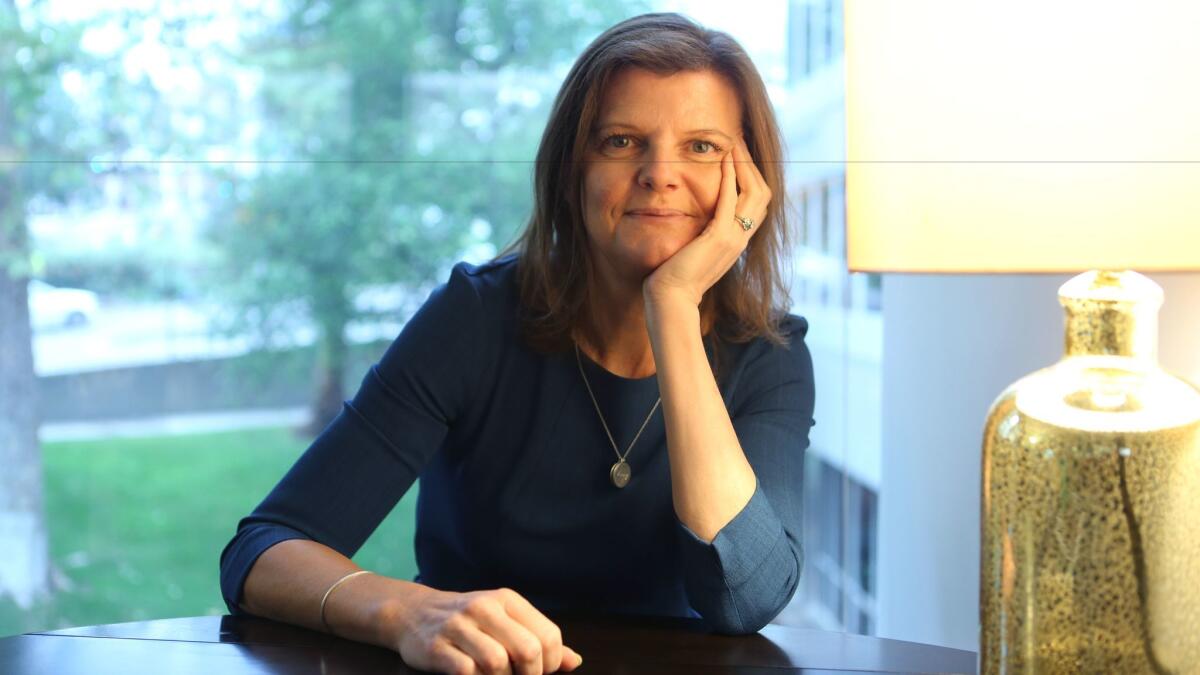āMarketplaceā is Americaās most popular business show. Now it has ambitious plans to expand

Weekday afternoons, millions of Americans ā many stuck in rush-hour traffic ā learn the business news of the day from Kai Ryssdal, a former Navy pilot and host of the public radio show āMarketplace.ā
āI spend almost as much time with Kai Ryssdal as I do with my own husband,ā joked Sally Kilbridge of Scottsdale, Ariz., who toughs out her more than two-hour-a-day commute by listening to public radio.
āMarketplace,ā which is produced in downtown Los Angeles by American Public Media, is the most popular business program on radio or TV in the U.S., with an average of 14.6 million listeners a week. In the last year, the 28-year-old program has seen its audience grow 16% ā benefiting from Americansā increased appetite for news.
Hoping to capitalize on its success, āMarketplaceā has launched an ambitious plan to remain a vital source for economic information as consumersā listening habits change, putting a strain the traditional broadcast model.
āWe cannot rest on the idea that listeners are always going to come to us,ā Deborah Clark, senior vice president and general manager of āMarketplaceāsā portfolio of programs, said in a recent interview. āTheyāve been a captive audience. Weāre on the radio and they know how to find us there ā but now people are not just looking toward the radio for the content.ā
Consumers have more choices, including in their cars. New vehicles are equipped with screens and technology that enable drivers to use voice-activated Internet-connected devices ā opening the floodgates of content available to commuters who spend hours in their cars and raising the level of competition for āMarketplace.ā
At the same time, consumers are adding to their homes smart speakers, such as Amazonās Echo, that connect with Internet radio. Tech-savvy and younger audiences are more in tune with podcasts and personalized music playlists than old-school radio.
Another threat exists in Washington: President Trump last month recommended eliminating government funding for public TV and radio. āMarketplaceā doesnāt directly receive any federal money. But if Congress goes along with Trumpās plan, local stations would face deep cuts and some might have to scale back on programming, perhaps dropping Marketplace.
Cognizant of these challenges, āMarketplaceā is expanding its staff, producing more audio podcasts and figuring out other ways to reach listeners and generate more revenue. The plan is to turn a show about business into a self-sustaining business that can prosper in the era of digital media.
āI want us to grow,ā said Ryssdal, the popular host of the flagship afternoon program. āWe need to be a go-to source about things that are happening in this economy. We need to grow to a point where our reputation matches our ambitions.ā
Key to āMarketplaceāsā strategy is cultivating listeners who are not devotees of public radio. Finding new sources of revenue also presents challenges because public broadcasters are not allowed to run overt commercial messages, and āMarketplaceāsā mission ā āraising the economic intelligence of the countryā ā puts a priority on education, not commerce.
āIāve always admired what āMarketplaceā does,ā said Ben Manilla, director of audio at UC Berkeleyās Graduate School of Journalism. āBut the question is how will the programming be delivered, how will it be paid for and how will people find it in this vast sea of content?ā
Weāre on the radio and they know how to find us there ā but now people are not just looking toward the radio for the content.
— Deborah Clark, āMarketplaceā senior vice president
āMarketplaceā has long been an outlier. The show launched in 1989 at Cal State Long Beachās KLON radio station before being acquired in 1990 by USC, which sold the operation a decade later to Minnesota Public Radio.
It now distributes the four āMarketplaceā programs ā a morning report, the flagship 30-minute afternoon show, the weekend report and āMarketplace Techā ā through American Public Media, the St. Paul, Minn.-based parent company. Together, the shows attract a larger audience than leading cable business programs such as Fox Newsā āYour World With Neil Cavuto,ā which draws nearly 2 million viewers an episode, according to Nielsen.
āMarketplaceāsā annual revenue is about $18 million, about two-thirds of which comes from corporate sponsors. About a quarter of the money comes from the carriage fees paid by radio stations that air its programming. More than 750 stations carry āMarketplace,ā including local stations KPCC-FM (89.3) in Pasadena and KCRW-FM (89.9) in Santa Monica.
The show has attracted loyal fans, including Kilbridge, associate director of the Donald W. Reynolds National Center for Business Journalism at Arizona State University in Phoenix. In the current polarized media environment, Kilbridge said she appreciates āMarketplaceāsā evenhanded treatment of the news and Ryssdalās humor and conversational style.
āKai dumbs it down without making me feel dumb,ā she said.
Workdays begin early at āMarketplaceāsā downtown Los Angeles offices that overlook a busy on-ramp to the Harbor Freeway. Ryssdal, 53, and a small contingent of editors huddle in a conference room, beginning at 7:30 a.m., to discuss the news of the day and prepare the lineup for the show that tapes at 2 p.m. Reporters then have four hours to complete their assignments, boiling down a complex subject into 90 seconds of audio.
Unlike many other radio broadcasts, Ryssdal writes his own script.
āThe me that you hear on the air is pretty much the me that you get in real life,ā said Ryssdal, who spent eight years in the military and four years with the U.S. State Department, including in China. He returned to the U.S. in the late 1990s, and while his wife attended graduate school, he worked at a Borders bookstore in Palo Alto and tried to figure out what career to pursue.
At the age of 34, he became an intern at San Francisco public radio station KQED-FM (88.5) ā and quickly got hooked.
He joined āMarketplaceā in 2001, moving his family to Los Angeles and working the overnight shift to anchor the morning report, which is now produced in New York with David Brancaccio. Ryssdal became the host of the afternoon show nearly 12 years ago.
We need to grow to a point where our reputation matches our ambitions.
— Kai Ryssdal, āMarketplaceā host
On this morning, he and his Oakland-based colleague Molly Wood recorded an episode of their recently launched digital podcast, āMake Me Smart With Kai and Molly.ā
āThis is an opportunity for us to go in spaces we havenāt been,ā he said in an interview. āThereās a giant universe of people out there who donāt know what public radio is, and they are [into] podcasts.ā
According to Edison Research, podcasts (digital audio broadcasts) have become one of the fastest-growing media formats. About 24% of the U.S. population listens to at least one podcast a month, according to an Edison survey this year, compared with 12% in 2010. The audience skews young; about twice as many listeners ages 12 to 24 download these audio stories compared with those over 55.
āThe spoken word isnāt old-fashioned anymore,ā said Megan Lazovick, director of research for Edison Research in New Jersey, adding the rise in podcasts correlates with the adoption of smart phones. āPodcasts are not going to replace radio, but it is really growing. There is a podcast for everyone.ā

āMarketplaceā is well-positioned to capitalize on the trend because it has expertise in audio storytelling and high production values. The team has produced podcasts for more than five years and its podcasts now reach an audience of 5 million. The group now markets half a dozen podcasts, including āCode Breaker,ā a series with Tech Insider; āThe Uncertain Hour,ā a documentary series about welfare reform; and Corner Office, Ryssdalās conversations with big-name chief executives.
āMake Me Smart With Kai and Mollyā is more personality-driven and more casual than the radio broadcasts. For example, a recent episode was: āAvocado toast is really a story about NAFTA.ā
āMarketplaceā has tackled complex stories, such as a current series called āThe Big Promise,ā which explores Trumpās campaign promises and why voters embraced him. Ryssdal and other reporters have been focusing on the economy in Erie, Pa., which went for Trump in the last election. Another current series, āRobot-Proof Jobs,ā examines how automation is displacing traditional jobs.
Three-quarters of āMarketplaceāsā audience comes from the radio broadcasts, but Clark, the general manager, expects the mix to change as audiences shift to digital sources.
Changing viewer habits prompted āMarketplaceāsā new business plan, not the proposed cuts in Washington, Clark said.
Clark plans to add nearly a dozen employees to āMarketplaceāsā staff of 85, and she recently hired a chief operating officer, public radio veteran Mark Crowley, to explore revenue opportunities, including live events, āMarketplaceā video games and perhaps even creating educational materials for school curriculum.
āThis is about taking our brand and building it in a way that allows us to introduce our form of storytelling to more people,ā Clark said. āThis also is about putting some more meat on the bones and positioning for the future.ā
ALSO
United fiasco shows airlinesā power over passengers ā and how it might change
Mammoth Resorts to be bought by Colorado partnership
Wal-Mart to discount online-only items delivered to stores
UPDATES:
3:10 p.m.: This article was updated with additional ratings information.
April 12, 8:07 a.m.: This article has been updated to clarify that āMarketplaceā is the most popular business broadcast on radio or TV in the U.S.
This article was originally published at 3 a.m.
More to Read
Inside the business of entertainment
The Wide Shot brings you news, analysis and insights on everything from streaming wars to production ā and what it all means for the future.
You may occasionally receive promotional content from the Los Angeles Times.











